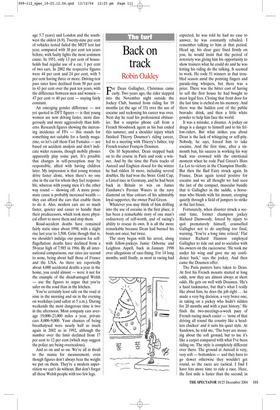Figure it out
Alan Judd
Years ago, when the Times was a newspaper for grown-ups, it was said to have published a letter illustrative of our misuse of statistics. This was to the effect that there were about 3 million people in Wales, of whom about 3,000 had one leg and 300 no legs at all. Thus, the ‘average’ number of legs per person in Wales was 1.99 whatever, and therefore ‘most’ people in Wales had fewer than two legs.
We read such basic statistical errors daily. Even the sad figures for road deaths over the Christmas period — intended to shock — are sometimes misleading, albeit differently, because it’s not always pointed out that Christmas figures are usually significantly lower than those for other times of the year. Or — different again — when the London Health Observatory tells us that road accidents in London ‘cost’ the health service £29 million, can we be sure that this figure does not include salaries and capital costs that would have been paid anyway? Did they set the cost of the unfortunates who died against what they would have cost the health service if they’d lived to die of natural causes?
Happily, there are many more cheerful transport statistics to be found on the Department for Transport website at www.dft.gov.uk. It is a pleasure, in these environmentally obsessed days, to find that there were nearly twice as many cars of over three litres on the road in 2003 as there were in 1993. Nor are they all 4x4s (some of which, incidentally, score better in pedestrian crash tests than conventional saloons). Unexpectedly, the north-east tends to have the newest vehicles (average age 5.7 years) and London and the southwest the oldest (6.9). Twenty-nine per cent of vehicles tested failed the MOT test last year, compared with 38 per cent ten years before, with faulty lights the most common cause. In 1951, only 13 per cent of households had regular use of a car, 1 per cent of two cars. In 2002 the respective figures were 44 per cent and 24 per cent, with 5 per cent having three or more. Driving-test pass rates have declined from 50 per cent to 43 per cent over the past ten years, with the difference between men and women 47 per cent vs 40 per cent — staying fairly constant.
An emerging gender difference — not yet quoted in DFT figures — is that young women are now driving faster, more dangerously and more aggressively than hitherto. Research figures showing the increasing incidence of FFs — this stands for something not suitable for a family magazine, so let’s call them Fast Females — are based on accident analysis and don’t indicate wider reasons, though mobile phones apparently play some part. It’s possible that changes in self-perception may be responsible, allied with having children later. My impression is that young women drive faster alone, when there’s no one else in the car for whom they feel responsible, whereas with young men it’s the other way round — showing off. A more proximate cause is probably increased wealth they can afford the cars that enable them to do it. Also, modern cars are so much faster, quieter and easier to handle than their predecessors, which took more physical effort to move them and stop them.
Road-accident deaths have remained fairly static since about 1998, with a slight rise last year to 3,508. Grim though that is, we shouldn’t indulge our passion for selfflagellation: deaths have declined from a 50-year high of 7,985 in 1966. By all international comparisons, our rates are second to none, being about half those of France and the USA. As there are reportedly about 4,000 accidental deaths a year in the home, you could almost — were it not for the example of the disadvantaged Welsh — use the figures to argue that you’re safer on the road than in the kitchen.
You’re certainly least safe on the road at nine in the morning and six in the evening on weekdays (and safest at 5 a.m.). During weekends the most dangerous time is two in the afternoon. Most company cars average 19,000–21,000 miles a year, private cars 8,000–9,000. Your chances of being breathalysed were nearly half as much again in 2002 as in 1992, although the number over the limit declined from 17 per cent to 12 per cent (which may suggest the police are being overzealous).
And so on and so on. We’re all in thrall to the mania for measurement, even though figures don’t always bear the weight we put on them. They’re a modern superstition we can’t do without. But don’t forget all those Welsh people with too few legs.


















































































 Previous page
Previous page